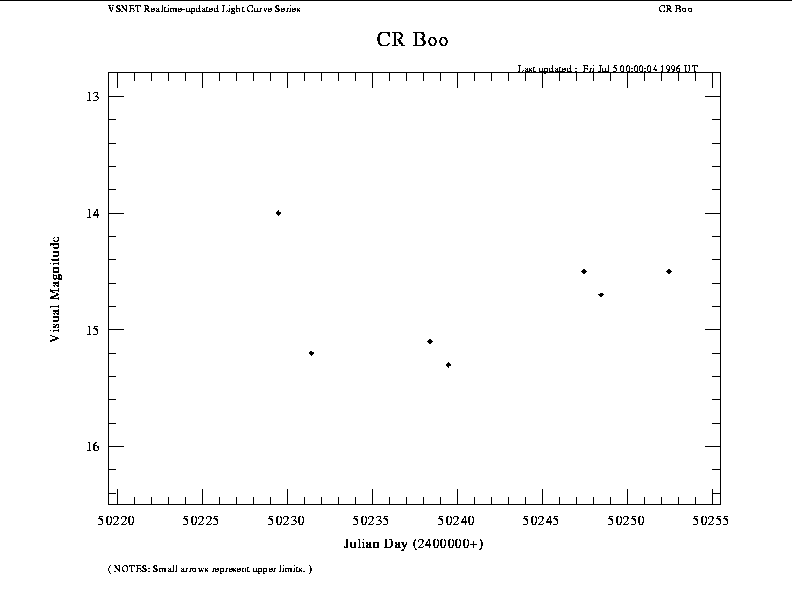
(from vsnet-obs 2633, Gary Poyner)
CR Boo:
I have observed many "outbursts" in this star over the years, but I
am unable to find an accurate classification of it's type. The TA
chart I use has it noted as type AM? (which is clearly in error).
In MVS June 1994, W. Wenzel has produced a short paper on CR Boo,
stating that it is a member of a helium white dwarf binary system,
which mimics a dwarf nova with frequent outbursts. Can anyone shed
more light on this interesting star?
(vsnet 606, Joe Patterson)
Oh, for joy! Someone wants to know about CR Boo! (=PG1346+082)
This star is an AM CVn type cataclysmic variable, a very close binary where the gas transferred to the accretion disk is helium rather than (mostly) hydrogen. It ranges between mag 13.5 and 17.5, and "erupts" (if that's the word) extremely often. Everything happens fast in this star - the orbital period is probably 1471 s, the superhump period around 1490 s, and the star shows large luminosity variations on a timescale of 1-2 days. It's probably, though not obviously, fair to call these dwarf nova eruptions, since the star's spectrum changes in the standard dwarf-nova manner. Thus you could perhaps consider CR Boo the most prolific dwarf nova in the sky.
In February 1992 I observed this star for about 2 hours EVERY SINGLE NIGHT (it was a leap year, too), and although the star was always ramping up or down, I could not find a convincing period. The best candidates were in the 0.8-1.5 d range. Often I have wanted to observe this star over a range of longitudes, to overcome the 1 c/day aliasing that afflicts life on this rotating planet. Unfortunately the star is too faint for the great majority of visual observers. CCD and large- aperture folks could do it, though.
Is anyone out there interested? We have an observing run in Chile during May 7-25 when we can expect to observe the star every clear night. If we got help from other longitudes during that interval, we might actually be able to discover that elusive period!
There are risks, however. Well maybe not exactly "risks", but possibilities of non-success. If the star is truly a dwarf nova (plausible), then maybe there IS no definite period, since dwarf novae are often poor clocks. Also, in addition to these episodes of very vigorous up-and-down activity, there are also times the star just hangs around 17th mag ("low state"). And there may well be episodes of getting stuck near the high state too, though I'm not sure I've ever seen one. In either case, a close monitoring program would fail to reveal the eruption period (though might reveal other things).
A most excellent paper on CR Boo is Wood et al. 1987, ApJ 313, 757. Anna Ulla wrote a very good review of AM CVn stars in Space Science Reviews 67, 241 (1994). Judi Provencal also wrote an extensive description of the "Whole Earth Telescope" photometry of CR Boo in her PhD thesis (approx. 1994), but I haven't seen it in a journal yet.
Anyone interested in that May campaign, I'd love to hear from you at jop@tristram.phys.columbia.edu
Joe Patterson
Dept of Astronomy, Columbia Univ
New York, NY 10027
CR Boo campaign, update (May 13)

VSNET light curve

Since the introduction of this variable star by S. Fujino to a Japanese popular astronomical magazine in 1987, CR Boo has been a favorite target by some enthusiastic observers of the VSOLJ.
Light curve (1987-1990)

